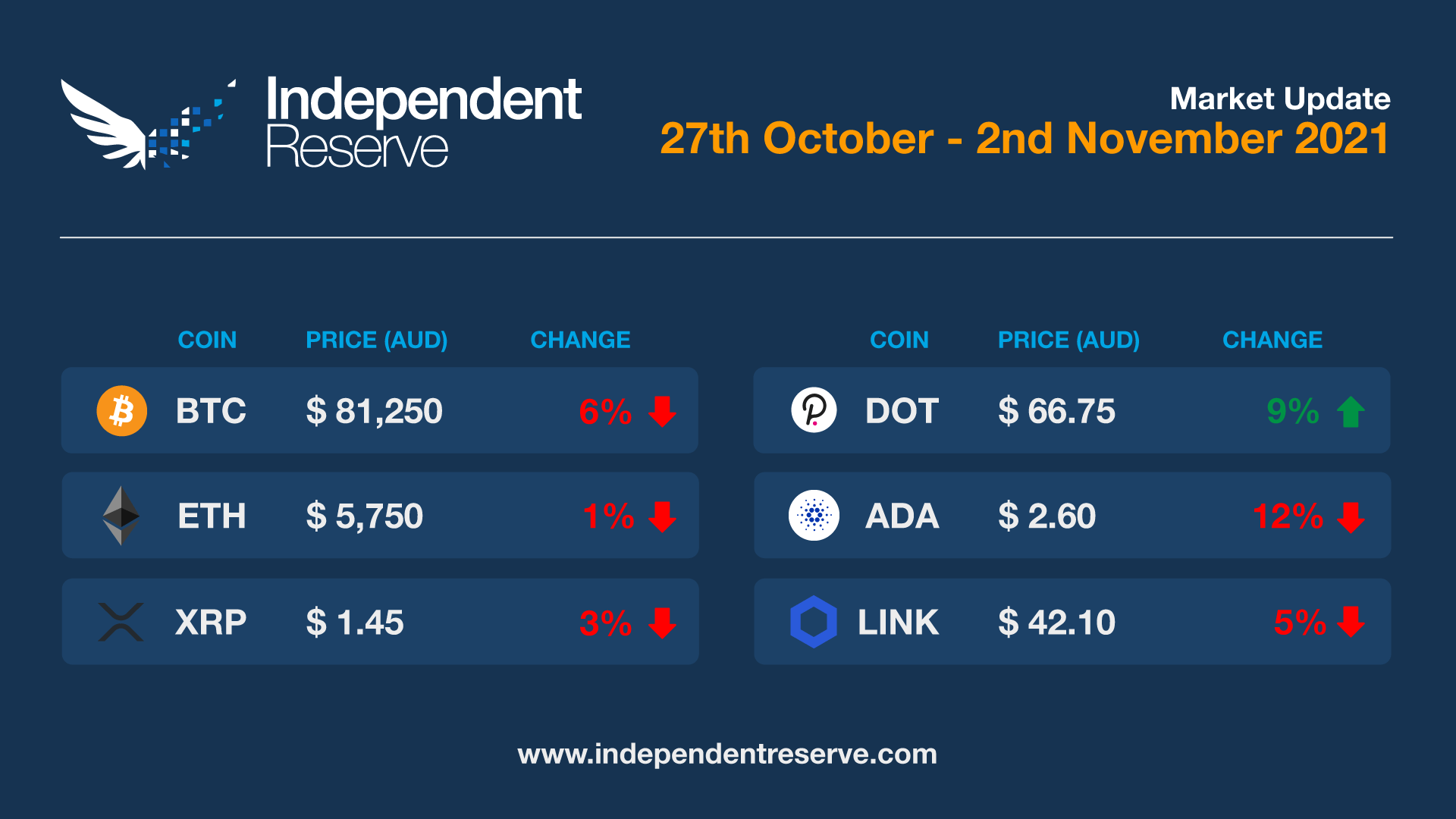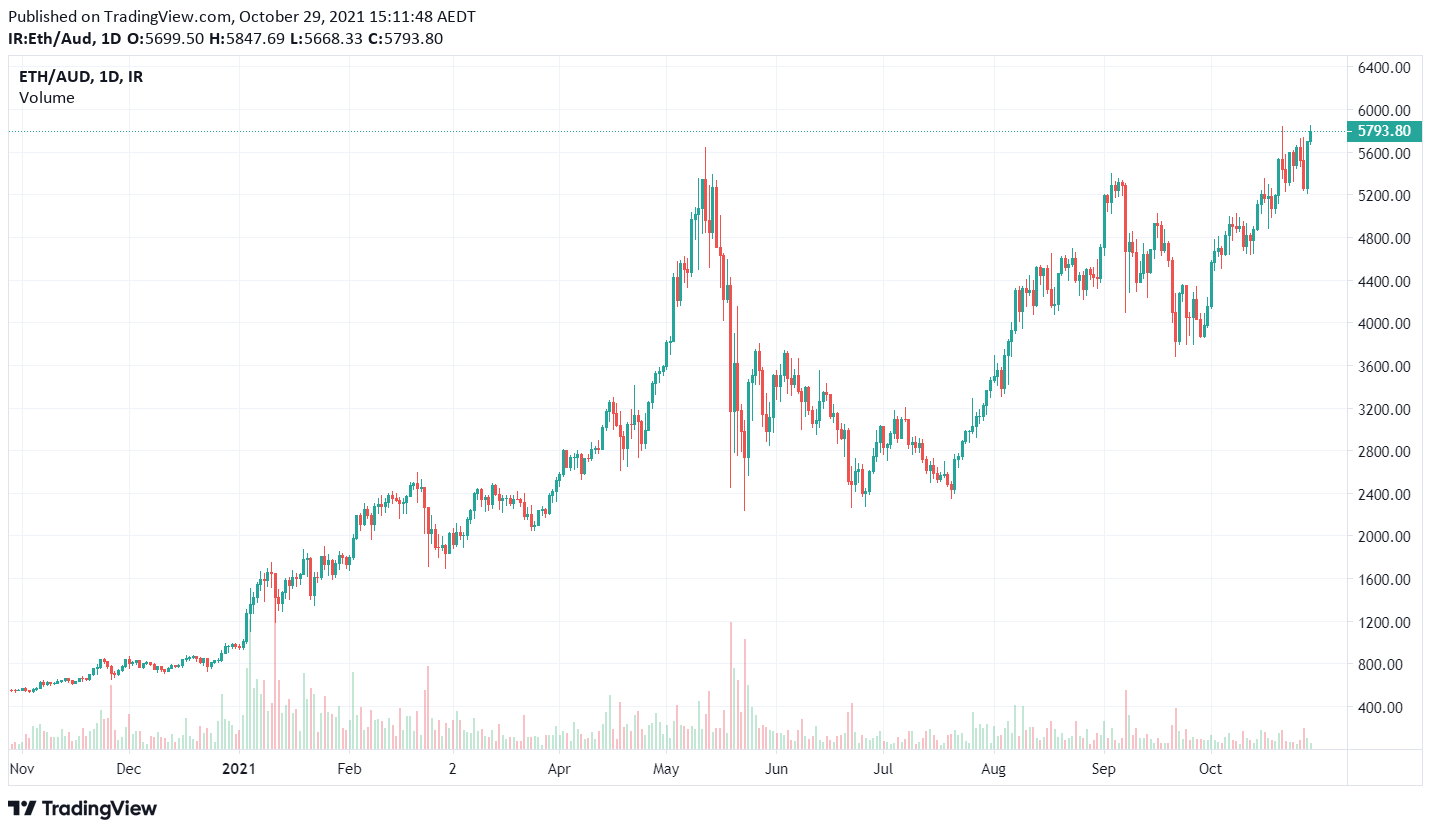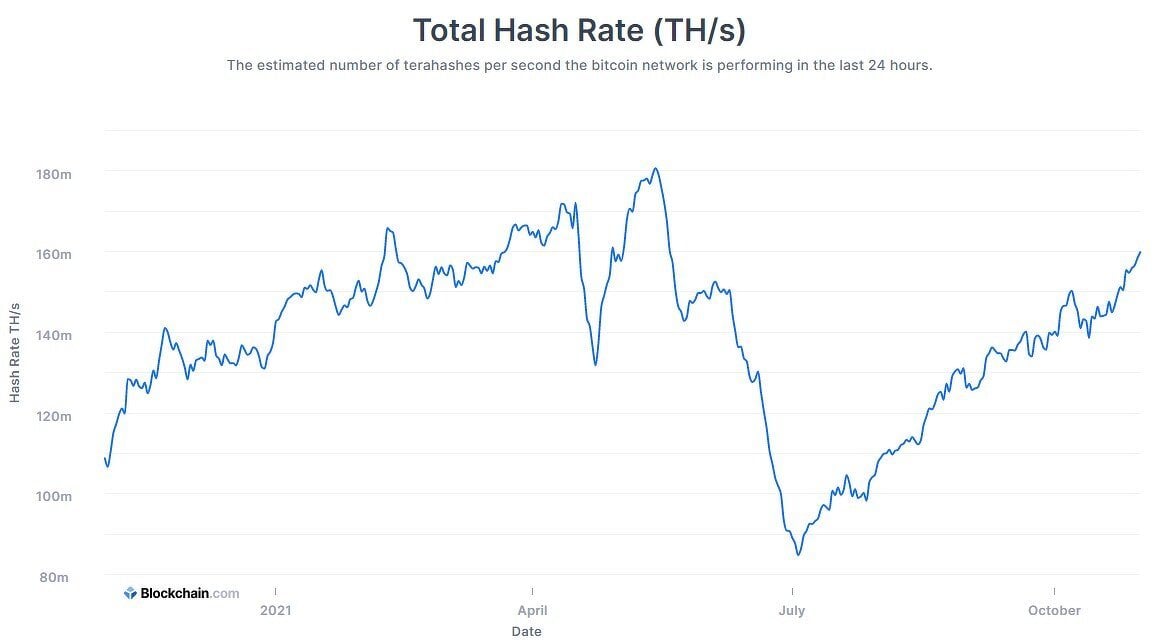In Markets
Uptober was a great month for investors, with Bitcoin up 39.9%, for the best result since December last year. Glassnode points out that in USD value, the total price range of the candle of $23,205 (AU$30,850) was larger than Bitcoin’s entire price range in the decade or so from genesis to December 2020. (Incidentally, October 31 marked 13 years since the release of the Bitcoin white paper). This week however the coin fell 6% and finished up around AU$81,250. Ethereum also pushed into price discovery on October 29 with a half trillion USD market cap (AU$676B) and is currently around AU$5,750. XRP was fairly flat, Polkadot gained 9%, Dogecoin was up 2.2% (but was pushed out of the top ten by meme clone Shiba Inu), Uniswap gained 2.2% and Cardano lost 12%. The Crypto Fear and Greed Index is at 74 or Greed.

From the IR OTC Desk
Today is not only the day that stops the nation, with the annual running of the Melbourne Cup, but also one of the more significant dates in the Reserve Bank of Australia’s (RBA) meeting calendar. Last week we highlighted the importance of the Australian Q3 CPI release, which delivered a 3% annual inflation rate on the headline, and more importantly, a YoY Trimmed Mean of 2.1% (an underlying inflation rate now within the RBA’s 2-3% band). In the days following, the RBA appear to have permanently (yet to be confirmed officially) stepped back from their 0.1% 2024 yield target – a key function of their quantitative easing program – and domestic interest rates have moved to price in more than 100bps of interest rate hikes by the end of 2022 (live futures pricing).
The meeting today may provide additional colour on how the RBA interprets these events and whether they decide it is necessary to change their quantitative program and/or forward interest rate guidance. Pre the CPI release, communication was for rates to remain on hold until the beginning of 2024. Any change in language to the forward guidance will be carefully scrutinised by foreign exchange and domestic bond markets. It is important to note that the RBA has always shown a very calming approach to policy setting.
On the OTC desk this week, the talk of the town has been DeFi 2.0 – think OHM, Time, Spell. With BTC taking a breather and the market broadly waiting for the next directional move, it was the ETH/BTC spread that trended higher, although well contained within the broader range. We continue to see some light profit taking in BTC and good OTC client interest from our Singapore office. We have remained a better buyer of USDC and a better seller of USDT. Noting that USDT has traded above 1:1 USD for the majority of the week.
For any trading needs, please don’t hesitate to get in touch.
In Headlines
ETH ATH
Ethereum blasted into a new all time high this week according to Coinmarketcap data, hitting US$4,455 (AU$5,923) per ETH. The high comes on the back of the successful Altair upgrade to the Beacon Chain which paves the way for the merge with the Ethereum mainnet. The ongoing interest in NFTs and DeFi also underscores the coin’s value with the network generating an average of US$65.5M (AU$87M) in fees every day. That’s about 70X higher than Bitcoin’s average and 15X more than Binance Smart Chain. High fees are bad for users of course, but are good for investors as part of the fees are burned, and 722,351 ETH has been burned so far (worth US$3.122B / AU$4.152B). Last week was also reportedly the first deflationary week in ETH’s history.

ETH breaking to new highs on the Independent Reserve exchange
Facebook metaverse
Facebook rebranded to Meta this week and hopes to muscle in on the metaverse being created by crypto people (a virtual world with digital ownerships). If this Mark Zuckerberg infomercial is any guide, it faces an uphill battle. Facebook has confirmed the metaverse will support NFTs, which Coin Desk called a “possible boost to the Ethereum protocol”. The rebrand was good news for metaverse style tokens including MANA, the token of Decentraland and The Sandbox, up 280% and 161% respectively.
BTC mining difficulty increase
Bitcoin mining difficulty has just increased by 7.85%. This is the eighth consecutive increase since July when the network began to recover from China’s mining ban. Difficulty hit a low of 13.67 trillion that month and has now hit 21.66 trillion, just shy of the 25.05T all time high in May. The network’s hash rate has surpassed 159 Th/s, which is the highest level since May.

Source: Blockchain.com
FATF releases updated guidance
The Financial Action Task Force has released the final version of its Guidance for Virtual Assets and Virtual Asset Service Providers (VASPs). After consultation the guidelines now say that DeFi projects aren’t considered VASPS if they are sufficiently decentralised. However “creators, owners and operators” holding control over the project or funds (let’s say with an admin key) may be considered a VASP. There’s also new guidance on the implementation of the travel rule, NFTs are not considered Virtual Assets and FATF decided to stop using the term ‘so called stablecoins’ and are just calling them stablecoins now.
Shiba increase is barking mad
Move over Dogecoin, there’s a new memecoin top dog in the top ten. Shiba Inu has gone ballistic in the past 30 days, gaining 800%, partly on rumors Robinhood is about to list it. It’s up 94,278,239% over the past year and some lucky investor who tipped US$8,000 (AU$10,600) into the coin last August has seen that stack turn into $5.7billion (AU$7.58B). Be warned though: Shiba Inu has an insanely large supply of half a quadrillion meaning there’s enough for everyone in the world to own 62,000 SHIB. The astonishing rise and fall of the Squid Game token this week should also make investors think twice about the risks of new meme coins.
ASIC considers spot Bitcoin ETF
ASIC has given Bitcoin and Ethereum ETFs a provisional green light and released a series of conditions such products need to meet. Funds will have to appoint a custodial crypto expert and front a minimum of $10 million in net tangible assets to launch an ETF as well as adhere to pricing disclosure and risk management obligations. In other ETF news, BetaShares is launching a crypto business ETF this week on the ASX (and is understood to be working on an actual Bitcoin ETF). The Bitcoin mining focused Cosmos Global Digital Miners Access ETF (DIGA) launched last week on the ASX’s biggest rival, Chi-X.
Crypto young rich listers
Synthetix founder Kain Warwick has made the Australian Financial Review young rich list at No 7 with a fortune of $879M. Brother Kieran is also on the list at 22 with $463M, as is another brother Grant (no 34 with $196M) as the pair cofounded play to earn game Illuvium. Sergio Segienko, founder of Chrono.tech is No 60 with $97M while Finder’s Fred Schebesta is at 29 with $340M. You can buy the Fin Review Magazine cover of the list as an NFT of course.
Bullish on price
Fundstrat cofounder Tom Lee says the firm’s analysis suggests Bitcoin should top US$168,000 (AU$223K) before the end of the year. Given there’s only eight weeks and we haven’t hit his original 2021 prediction of US$100K (AU$133K) yet, this seems like a tall order, but Lee revised the prediction upward in light of the interest generated by the Bitcoin futures ETFs and the potential for big money to invest in them. December is often a great month for Bitcoin prices too. Meanwhile, on-chain analyst Willy Woo says the previous generation of Bitcoin investors are being replaced by “high net worth purchasers” like family offices and rich people buying $1M worth at a time. He’s tipping a six figure price for BTC within six months.
Grayscale’s spot ETF Roadmap
According to one of Grayscale’s executives, the launch of their Bitcoin ETF could be as soon as July 2022. David LaValle, global head of ETFs for Grayscale, spoke at a virtual event outlining a nine-month timeline for approval by United States regulators. The ETF would be a transformation of what is currently the largest-volume Bitcoin investment product, Grayscale Bitcoin Trust (GBTC). LaValle felt the timing for submitting the application this week was ideal. “Now that the Bitcoin futures products were somewhat off the plate of the SEC, they would be open to look at the filings of spot-based products.”
Stimulus cheque profits
After receiving three rounds of stimulus cheques from the US Government, as of April 2020, the average American taxpayer had three opportunities to invest in Bitcoin. So how would they have performed if they invested? Based on average payouts of US$1,200 in April 2020, US$600 in December 2020, and US$1,400, an investment of roughly US$3,200 at these points in the market would have returned a total profit of US$4,514 or around 141%. Following Plan B’s S2F model which suggests Bitcoin will exceed US$98,000 in value, the stimulus cheque investments would return a further 58% in profits. However, according to a Cointelegraph report, only 11% of respondents invested part of their cheques into cryptocurrencies.
Until next week, happy trading!


